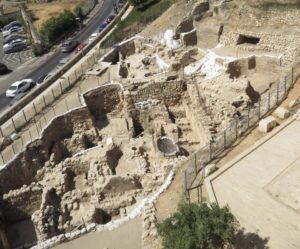
Much of what we know about the account of the infamous destruction of ancient Jerusalem by the military campaign of the Babylonian King Nebuchadnezzar in the 6th century B.C.E. derives from well-known written documents, particularly the Bible. It attests to a protracted siege of the city, followed finally by a successful breach that led to King Zedekiah’s (the king of Jerusalem) capture and a violent end to the city:
“Now in the fifth month, on the seventh day of the month, which was the nineteenth year of king Nebuchadnezzar, king of Babylon, came Nebuzaradan the captain of the guard, a servant of the king of Babylon, unto Jerusalem.
And he burnt the house of the LORD, and the king’s house; and all the houses of Jerusalem, even every great man’s house, burnt he with fire.
And all the army of the Chaldeans, that were with the captain of the guard, broke down the walls of Jerusalem round about.
And the residue of the people that were left in the city, and those that fell away, that fell to the king of Babylon, and the residue of the multitude, did Nebuzaradan the captain of the guard carry away captive.”*
Jerusalem’s king, Zedekiah, was seized by pursuing Babylonian forces during his flight from the city. Carried away to the king of Babylon, his sons were killed before his eyes, after which he was blinded and taken to Babylon in fetters.
It makes for a gruesome and sad story. But after 2,600 years, little remains outside the written account to verify the reality of the event.
In 2019, however, archaeologists in two separate excavations uncovered tantalizing new finds that point to a massive destruction that took place in Jerusalem, likely coinciding, they say, with the time assigned to the Babylonian destruction……….
The City of David Excavations
Arguably one of the largest excavations in Jerusalem, known popularly as the “City of David Excavations” in the Givati Parking Lot in the Tyropoeon Valley, has turned up some fascinating finds bearing on the history of the ancient city. Perhaps best known here were the excavations conducted by Doron Ben-Ami of Hebrew University and Yana Tchekhanovets of the Israel Antiquities Authority, who, since 2007, unearthed the basement of a large residential building dated to the Second Temple period — possibly the royal residence of Queen Helene, the queen who converted to Judaism; a large Roman period residential building wherein was found a gold earring inlaid with pearls and precious stones and a Roman boxer figurine weight; a Byzantine period building that yielded 264 gold coins; and evidence of later Muslim occupation, among many other finds. But it was during more recent excavations into the more ancient, Iron Age layers of the site where archaeologists Yuval Gadot of Tel Aviv University and Yiftah Shalev of the Israel Antiquities Authority and their team discovered the remains of what was interpreted as a large public building, showing evidence of a fiery destruction in the sixth century BCE – likely, they suggest, from the Babylonian destruction of Jerusalem in 586 BCE. They uncovered stone debris, burnt wooden beams, and charred pottery shards. It had to have been a very important building, they maintain, as it featured finely cut ashlar stones and other architectural elements typical of such buildings, including a polished plaster floor. But even more intriguing was the finding of two small artifacts — a clay bulla (seal impression) and a stamp-seal featuring names in ancient Hebrew characters in a script style consistent with the 6th century BCE. During this time period, administrative officials used bullae, or small pieces of wet clay, on which to impress personal seals as official signatures for correspondence and other documents of parchment. The parchment is eventually destroyed by events or time but the clay bullae survive to be recovered by archaeologists and others in modern times. The stamp-seals, such as the incised bluish agate stone seal discovered in this excavation, were used to make bullae impressions.
According to Gadot and Shalev, “The discovery of a public building such as this, on the western slope of the City of David, provides a lot of information about the city’s structure during this period and the size of its administrative area. The destruction of this building in the fire, apparently during the Babylonian conquest of the city in 586 BCE, strengthens our understanding of the intensity of the destruction in the city.”**
_____________________________
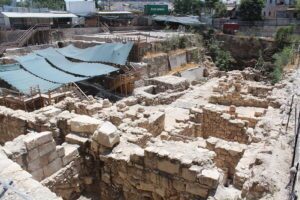
Above and below: Views of the Givati Parking Lot excavations. Deror Avi, Wikimedia Commons
_____________________________
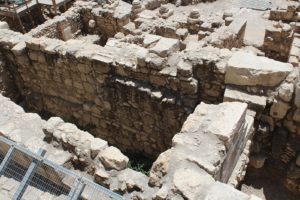
_____________________________
The Mount Zion Excavations
Not far from the Givati Parking Lot excavations, in an area adjacent to and below the southern Old City wall of Jerusalem, a team led by UNC Charlotte professor of history Shimon Gibson, Rafi Lewis of the Ashkelon Academic College, and James Tabor, UNC Charlotte professor of religious studies, have since 2007 conducted excavations that have revealed a layer-cake account of Jerusalem’s history revealed by artifacts and a sequence of structural remains dating back 3,000 years, from Medieval times back to the period of the Judahite monarchies hundreds of years before the time of Jesus. This excavation, in no small measure, has produced a number of remarkable finds relating to all of these time periods, including vaulted basement remains of aristocratic residential dwellings of the time of Herod the Great, a Byzantine street, and a defense ditch that was part of the fortifications encountered by the Crusaders’ campaign against Jerusalem in 1099 CE. Smaller finds included a white limestone cup dating from the first century CE, bearing an incised inscription; a first century CE plastered bathtub; and a 30-foot deep oval-shaped first century CE cistern that contained cooking pots, charcoal, evidence of burn marks, storage jars, and remains of an oven.
Most recently, however, the Mount Zion team uncovered evidence the excavation leadership suggest are evidentiary markers of the 587/586 BCE destruction of Jerusalem by Nebuchadnezzar. The evidence includes ash deposits, arrowheads of the type used by the ancient Babylonian forces of the period, Iron Age potsherds, oil lamps typical of the period, and a gold and silver tassel or earring. They have also detected signs of “a significant Iron Age structure in the associated area”.*** Full excavation of that building, however, must await future seasons, as it still underlies remains associated with later time periods.
But even before excavation of the building, Gibson believes the current finds are telling.
“For archaeologists, an ashen layer can mean a number of different things,” said Gibson in a report about the finds in the UNC Charlotte article, published on August 11. “It could be ashy deposits removed from ovens; or it could be localized burning of garbage. However, in this case, the combination of an ashy layer full of artifacts, mixed with arrowheads, and a very special ornament indicates some kind of devastation and destruction. Nobody abandons golden jewelry and nobody has arrowheads in their domestic refuse.”
“The arrowheads are known as ‘Scythian arrowheads’ and have been found at other archaeological conflict sites from the 7th and 6th centuries BCE,” Gibson continues. “They are known at sites outside of Israel as well. They were fairly commonplace in this period and are known to be used by the Babylonian warriors. Together, this evidence points to the historical conquest of the city by Babylon because the only major destruction we have in Jerusalem for this period is the conquest of 587/586 BCE.”***
Gibson and his colleagues hope to excavate into the associated Iron Age structure remains in a future season, shedding additional light on the time period and the event that occurred at the location.
_____________________________

Overhead view of the Mount Zion excavation site. UNC Charlotte and Mt Zion Archaeological Expedition
_____________________________
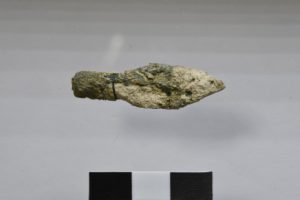
One of the Scythian type arrowheads found in the destruction layer from 587/586 BCE. Mt Zion Archaeological Expedition/Virginia Withers
_____________________________
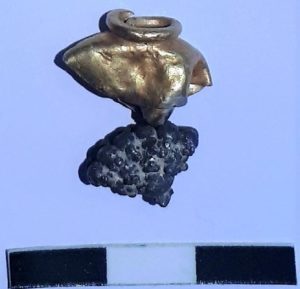
Earring or tassle ornament made of gold and silver from the destruction layer of 587/586 BCE. Mt Zion Archaeological Expedition/Rafi Lewis
_____________________________
*2 Kings 25: 8 — 11
**Rare seal bearing biblical name found in City of David excavation, 31 Mar 2019, Israel Ministry of Foreign Affairs. (https://mfa.gov.il/MFA/IsraelExperience/History/Pages/Rare-seal-bearing-biblical-name-found-in-City-of-David-excavation-31-March-2019.aspx#)
***Evidence of the Babylonian conquest of Jerusalem found in Mount Zion excavation, University of North Carolina at Charlotte news release, 11 Aug 2019.
_____________________________
If you liked this article, you may like Digging into First Century Jerusalem’s Rich and Famous, an in-depth feature article about the Mount Zion excavations published previously in Popular Archaeology.




